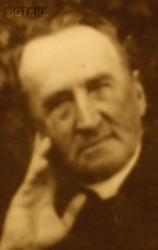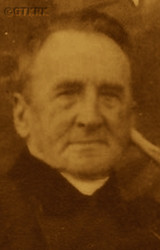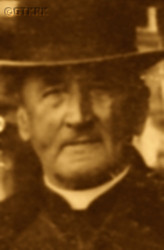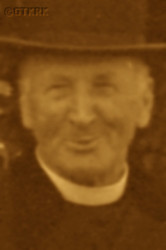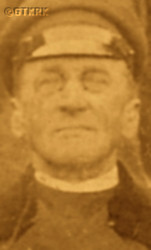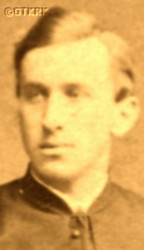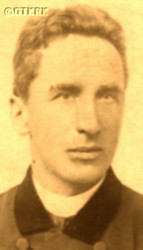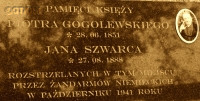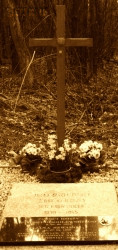Roman Catholic
St Sigismund parish
05-507 Słomczyn
85 Wiślana Str.
Konstancin deanery
Warsaw archdiocese, Poland
full list:
displayClick to display full list

searchClick to search full list by categories
wyświetlKliknij by wyświetlić pełną listę po polsku

szukajKliknij by przeszukać listę wg kategorii po polsku

Martyrology of the clergy — Poland
XX century (1914 – 1989)
personal data
surname
GOGOLEWSKI
forename(s)
Peter (pl. Piotr)
function
diocesan priest
creed
Latin (Roman Catholic) Church RCmore on
en.wikipedia.org
[access: 2014.09.21]
diocese / province
Włocławek diocesemore on
en.wikipedia.org
[access: 2013.05.19]
Włocławek i.e. Kalisz diocesemore on
pl.wikipedia.org
[access: 2019.10.13]
academic distinctions
Sacred Theology Candidate
honorary titles
honorary canonmore on
honorary canon
(Assumption of the Blessed Virgin Mary RC collegiate church, Kalisztoday: Kalisz city pov., Greater Poland voiv., Poland
more on
en.wikipedia.org
[access: 2020.12.16])
date and place
of death
20.10.1941

Pyzdrytoday: Pyzdry gm., Września pov., Greater Poland voiv., Poland
more on
en.wikipedia.org
[access: 2020.11.27]
alt. dates and places
of death
06.10.1941
details of death
After German and Russian invasion of Poland in 09.1939 and start of the World War II, after start of German occupation, arrested by the Germans on 06.10.1941, as part of the action to eliminate the Polish Catholic clergy in the Germ. Reichsgau Wartheland province, established in the occupied Greater Poland region — together with a group of priests resident in the Retired Priests' House in Ciechocinek, during eviction of the sisters that run it. Interned in IL Lond transit camp in Ląd.
From there — as the oldest in the group — taken out and murdered by the Germans together with Fr John Szwarc in the forest n. Pyzdry, by the Kruszyna forester's house.
cause of death
mass murder
perpetrators
Germans
sites and events
«Aktion T4»Click to display the description, IL LondClick to display the description, 06.10.1941 arrests (Warthegau)Click to display the description, Reichsgau WarthelandClick to display the description, Ribbentrop‐MolotovClick to display the description, Pius XI's encyclicalsClick to display the description
date and place
of birth
28.07.1851Birth certification on:
metryki.genealodzy.pl
[access: 2025.03.27]

Tuszyntoday: Tuszyn gm., Łódź‐east pov., Łódź voiv., Poland
more on
en.wikipedia.org
[access: 2021.12.18]
parents
GOGOLEWSKI Louis
🞲 ?, ? — 🕆 ?, ?

JANEK Julianna
🞲 ?, ? — 🕆 ?, ?
baptism
03.08.1951Birth certification on:
metryki.genealodzy.pl
[access: 2025.03.27]

Tuszynek Duchownytoday: part of Tuszyn, Tuszyn gm., Łódź‐east pov., Łódź voiv., Poland
more on
en.wikipedia.org
[access: 2021.12.18]
St Vitalis the Martyr RC church
presbyter (holy orders)
ordination
29.06.1876

positions held
1922 – 1941
pensioner — Ciechocinektoday: Ciechocinek gm., Aleksandrów Kujawski pov., Kuyavia‐Pomerania voiv., Poland
more on
en.wikipedia.org
[access: 2020.12.16] ⋄ Manor House „Under the Eagle”, House of Retired Priests, run by St Honorat Sisters CPSICM
1914 – 1922
administrator — Czastarytoday: Czastary gm., Wieruszów pov., Łódź voiv., Poland
more on
en.wikipedia.org
[access: 2022.01.28] ⋄ Nativity of the Blessed Virgin Mary RC parish ⋄ Wieluńtoday: Wieluń gm., Wieluń pov., Łódź voiv., Poland
more on
en.wikipedia.org
[access: 2021.07.18] RC deanery
1907 – 1914
administrator — Walichnowytoday: Sokolniki gm., Wieruszów pov., Łódź voiv., Poland
more on
en.wikipedia.org
[access: 2020.12.16] ⋄ St Martin the Bishop and Confessor RC parish ⋄ Wieluńtoday: Wieluń gm., Wieluń pov., Łódź voiv., Poland
more on
en.wikipedia.org
[access: 2021.07.18] RC deanery
1903 – 1907
administrator — Czarnożyłytoday: Czarnożyły gm., Wieluń pov., Łódź voiv., Poland
more on
en.wikipedia.org
[access: 2020.12.16] ⋄ St Bartholomew the Apostle RC parish ⋄ Wieluńtoday: Wieluń gm., Wieluń pov., Łódź voiv., Poland
more on
en.wikipedia.org
[access: 2021.07.18] RC deanery
1891 – 1903
administrator — Kobiele Wielkietoday: Kobiele Wielkie gm., Radomsko pov., Łódź voiv., Poland
more on
en.wikipedia.org
[access: 2021.07.29] ⋄ St John the Evangelist and St Martin the Bishop and Confessor RC parish ⋄ Radomskotoday: Radomsko gm., Radomsko pov., Łódź voiv., Poland
more on
en.wikipedia.org
[access: 2021.12.18] RC deanery
1886 – 1891
administrator — Zadzimtoday: Zadzim gm., Poddębice pov., Łódź voiv., Poland
more on
en.wikipedia.org
[access: 2020.12.16] ⋄ St Margaret the Virgin and Martyr RC parish ⋄ Sieradztoday: Sieradz urban gm., Sieradz pov., Łódź voiv., Poland
more on
en.wikipedia.org
[access: 2020.11.05] RC deanery
1884 – 1886
administrator — Buczektoday: Buczek gm., Łask pov., Łódź voiv., Poland
more on
en.wikipedia.org
[access: 2020.12.16] ⋄ St John the Baptist RC parish ⋄ Łasktoday: Łask gm., Łask pov., Łódź voiv., Poland
more on
en.wikipedia.org
[access: 2020.11.01] RC deanery
1882 – 1884
vicar — Kłomnicetoday: Kłomnice gm., Częstochowa pov., Silesia voiv., Poland
more on
en.wikipedia.org
[access: 2020.12.11] ⋄ St Martin the Bishop and Confessor RC parish ⋄ Radomskotoday: Radomsko gm., Radomsko pov., Łódź voiv., Poland
more on
en.wikipedia.org
[access: 2021.12.18] RC deanery
1880 – 1882
vicar — Pajęcznotoday: Pajęczno gm., Pajęczno pov., Łódź voiv., Poland
more on
en.wikipedia.org
[access: 2020.12.11] ⋄ Assumption of the Blessed Virgin Mary RC church ⋄ St Leonard the Confessor RC parish ⋄ Noworadomskotoday: from 13.09.1922 Radomsko, Radomsko urban gm., Radomsko pov., Łódź voiv., Poland
more on
en.wikipedia.org
[access: 2021.12.18] RC deanery
1879 – 1880
vicar — Turektoday: Turek gm., Turek pov., Greater Poland voiv., Poland
more on
en.wikipedia.org
[access: 2020.12.11] ⋄ St John the Baptist RC parish ⋄ Turektoday: Turek gm., Turek pov., Greater Poland voiv., Poland
more on
en.wikipedia.org
[access: 2020.12.11] RC deanery
1878 – 1879
vicar — Kalisztoday: Kalisz city pov., Greater Poland voiv., Poland
more on
en.wikipedia.org
[access: 2020.12.16] ⋄ St Nicholas the Bishop and Confessor RC parish ⋄ Kalisztoday: Kalisz city pov., Greater Poland voiv., Poland
more on
en.wikipedia.org
[access: 2020.12.16] RC deanery
1877 – 1878
vicar — Opatówektoday: Opatówek gm., Kalisz pov., Greater Poland voiv., Poland
more on
en.wikipedia.org
[access: 2020.11.01] ⋄ St Dorothy Virgin and Martyr RC parish ⋄ Kalisztoday: Kalisz city pov., Greater Poland voiv., Poland
more on
en.wikipedia.org
[access: 2020.12.16] RC deanery
1873 – 1877
student — Sankt Petersburgtoday: Saint Petersburg city, Russia
more on
en.wikipedia.org
[access: 2020.07.31] ⋄ philosophy and theology, Imperial Roman Catholic Spiritual Academy (1842‐1918) — postgraduate specialised studies crowned with Sacred Theology Candidate's degree
1871 – 1873
student — Włocławektoday: Włocławek city pov., Kuyavia‐Pomerania voiv., Poland
more on
en.wikipedia.org
[access: 2021.12.18] ⋄ philosophy and theology, Theological Seminary
others related
in death
SZWARCClick to display biography John
sites and events
descriptions
«Aktion T4»: German state euthanasia program, systematic murder of people mentally retarded, chronically, mentally and neurologically ill — „elimination of live not worth living” (Germ. „Vernichtung von lebensunwertem Leben”). At a peak, in 1940‐1941, c. 70,000 people were murdered, including patients of psychiatric hospitals in German occupied Poland — German formalists noted then that, among others, „performing disinfection [i.e. gassing] of 70,273 people with a life expectancy of up to 10 years saved food in the amount of 141,775,573.80 Deutschmark”. From 04.1941 also mentally ill and „disabled” (i.e. unable to work) prisoners held in German concentration camps were included in the program — denoted then as «Aktion 14 f 13». C. 20,000 inmates were then murdered, including Polish Catholic priests held in KL Dachau concentration camp, who were murdered in Hartheim gas chambers. The other „regional extension” of «Aktion T4» was «Aktion Brandt» program during which Germans murdered chronically ill patients in order to make space for wounded soldiers. It is estimated that at least 30,000 were murdered in this program. (more on: en.wikipedia.orgClick to attempt to display webpage
[access: 2014.10.31])
IL Lond: The Gestapo District Office in Poznań issued on 13.12.1939 executive instruction Ref. IIB No. 406/39 Tgb. No. 3045/39, ordering: „Based on the regulation of the Germ. Höherer SS‐ und Polizeiführer (Eng. Higher Commander of the SS and Police) [of the German province of Warthegau (Eng. Greater Poland)] of 12.11.1939 [SS‐Gruppenführer Wilhelm Koppe], apart from Poles and Jews, also Catholic clergy will be expelled. Action against this group of people should be carried out in such a way that internment and transport are separate […] C. 80% of Catholic clergy are expected to be expelled. The selection based on political threat posed. Internees cannot be placed in regular transit camps due to the possibility of international protest. Catholic clergy should be interned in men's monasteries and held there till mass transportation out”. And so in 1940‐1941, in a formerly Cistercian priory and monastery (today Salesian Institute) in Ląd on Warta river Germans set‐up a transit Germ. „Internierungslager” (Eng. „Internment camp”) for Polish priests and religious, from Włocławek, Gniezno, Warszawa, Poznań, Płock and Częstochowa dioceses and religious and monks from a number of congregations. Approx. 152 religious (70 till 03.04.1941 and 82 in 06‐28.10.1941) were held there prior to being sent to KL Dachau concentration camp. After the deportation, the Germans organized a training center for the German National Socialist youth wing, Germ. „Hitler‐Jugend” (Eng. „Hitler youth”), in the abbey. (more on: pl.wikipedia.orgClick to attempt to display webpage
[access: 2013.08.10], yadda.icm.edu.plClick to attempt to display webpage
[access: 2016.03.14])
06.10.1941 arrests (Warthegau): On 13.09.1941 Germ. Gauleiter (Eng. regional leader) of German province Germ. Reichsgau Wartheland (Eng. Wartheland Reich district), in German‐occupied Greater Poland (where German standard law was in force), Artur Greiser, implementing „Ohne Gott, ohne Religion, ohne Priesters und Sakramenten” — „without God, without religion, without priest and sacrament” — policy issued a decree formally dissolving Catholic Church and forming in its place a Roman Catholic German National Church in Germ. Warthegau, an organization subject to a German private law. The ordinance was issued backdated to 01.09.1939, i.e. the date of the German invasion of Poland, which sanctioned the later robbery of the property of the Catholic Church acting for the benefit of the Polish population by the Germans. All the contacts with Vatican were forbidden. All the religion congregations were also dissolved. Soon after, on 06‐07.10.1941, mass arrests of Polish Catholic priests took place — c. 352 were detained. All were herded into DL Konstantinow in Konstantynów or IL Lond in Ląd on Warta river transit camps or KL Posen concentration camp (in this case, the detainees were first registered, photographed and examined in the infamous Poznań headquarters of the German political police, the Gestapo, in the former Soldier's House). On 30.10.1941 most of them were transported to KL Dachau concentration camp.
Reichsgau Wartheland: After the Polish defeat in the 09.1939 campaign, which was the result of the Ribbentrop‐Molotov Pact and constituted the first stage of World War II, and the beginning of German occupation in part of Poland (in the other, eastern part of Poland, the Russian occupation began), the Germans divided the occupied Polish territory into five main regions (and a few smaller). The largest one was transformed into Germ. Generalgouvernement (Eng. General Governorate), intended exclusively for Poles and Jews and constituting part of the so‐called Germ. Großdeutschland (Eng. Greater Germany). Two were added to existing German provinces. From two other separate new provinces were created. Greater Poland region was one of them, incorporated into Germany on 08.10.1939, by decree of the German leader Adolf Hitler (formally came into force on 26.10.1939), and on 24.01.1940 transformed into the Germ. Reichsgau Wartheland province, in which the law of the German state was to apply. The main axis of the policy of the new province, the territory of which the Germans recognized as the Germ. „Ursprünglich Deutsche” (Eng. „natively German”), despite the fact that 90% of its inhabitants were Poles, was Germ. „Entpolonisierung” (Eng. „Depolonisation”), i.e. forced Germanization. C. 100,000 Poles were murdered as part of the Germ. „Intelligenzaktion”, i.e. extermination of Polish intelligentsia and ruling classes. C. 630,000 were forcibly resettled to the Germ. Generalgouvernement, and their place taken by the Germans brought from other areas occupied by Germany (e.g. the Baltic countries, Bessarabia, Bukovina, etc.). Poles were forced to sign the German nationality list, the Germ. Deutsche Volksliste DVL. As part of the policy of „Ohne Gott, ohne Religion, ohne Priesters und Sakramenten” (Eng. „No God, no religion, no priest or sacrament”) most Catholic priests were arrested and sent to concentration camps. All schools teaching in Polish, Polish libraries, theaters and museums were closed. Polish landed estates confiscated. To further reduce the number of the Polish population, Poles were sent to forced labor deep inside Germany, and the legal age of marriage for Poles was increased (25 for women, 28 for men). The German state office, Germ. Rasse‐ und Siedlungshauptamt (Eng. Main Office of Race and Settlement) RuSHA, under the majesty of German law, abducted several thousand children who met specific racial criteria from Polish families and subjected them to forced Germanization, handing them over to German families. After the end of hostilities of World War II, the overseer of this province, the Germ. Reichsstatthalter (Eng. Reich Governor) and the Germ. Gauleiter (Eng. district head) of the German National Socialist Party, Arthur Karl Greiser, was executed. (more on: en.wikipedia.orgClick to attempt to display webpage
[access: 2024.06.21])
Ribbentrop‐Molotov: Genocidal Russian‐German alliance pact between Russian leader Joseph Stalin and German leader Adolf Hitler signed on 23.08.1939 in Moscow by respective foreign ministers, Mr. Vyacheslav Molotov for Russia and Joachim von Ribbentrop for Germany. The pact sanctioned and was the direct cause of joint Russian and German invasion of Poland and the outbreak of the World War II in 09.1939. In a political sense, the pact was an attempt to restore the status quo ante before 1914, with one exception, namely the „commercial” exchange of the so‐called „Kingdom of Poland”, which in 1914 was part of the Russian Empire, fore Eastern Galicia (today's western Ukraine), in 1914 belonging to the Austro‐Hungarian Empire. Galicia, including Lviv, was to be taken over by the Russians, the „Kingdom of Poland” — under the name of the General Governorate — Germany. The resultant „war was one of the greatest calamities and dramas of humanity in history, for two atheistic and anti‐Christian ideologies — national and international socialism — rejected God and His fifth Decalogue commandment: Thou shall not kill!” (Abp Stanislav Gądecki, 01.09.2019). The decisions taken — backed up by the betrayal of the formal allies of Poland, France and Germany, which on 12.09.1939, at a joint conference in Abbeville, decided not to provide aid to attacked Poland and not to take military action against Germany (a clear breach of treaty obligations with Poland) — were on 28.09.1939 slightly altered and made more precise when a treaty on „German‐Russian boundaries and friendship” was agreed by the same murderous signatories. One of its findings was establishment of spheres of influence in Central and Eastern Europe and in consequence IV partition of Poland. In one of its secret annexes agreed, that: „the Signatories will not tolerate on its respective territories any Polish propaganda that affects the territory of the other Side. On their respective territories they will suppress all such propaganda and inform each other of the measures taken to accomplish it”. The agreements resulted in a series of meeting between two genocidal organization representing both sides — German Gestapo and Russian NKVD when coordination of efforts to exterminate Polish intelligentsia and Polish leading classes (in Germany called «Intelligenzaktion», in Russia took the form of Katyń massacres) where discussed. Resulted in deaths of hundreds of thousands of Polish intelligentsia, including thousands of priests presented here, and tens of millions of ordinary people,. The results of this Russian‐German pact lasted till 1989 and are still in evidence even today. (more on: en.wikipedia.orgClick to attempt to display webpage
[access: 2015.09.30])
Pius XI's encyclicals: Facing the creation of two totalitarian systems in Europe, which seemed to compete with each other, though there were more similarities than contradictions between them, Pope Pius XI issued in 03.1937 (within 5 days) two encyclicals. In the „Mit brennender Sorge” (Eng. „With Burning Concern”) published on 14.03.1938, condemned the national socialism prevailing in Germany. The Pope wrote: „Whoever, following the old Germanic‐pre‐Christian beliefs, puts various impersonal fate in the place of a personal God, denies the wisdom of God and Providence […], whoever exalts earthly values: race or nation, or state, or state system, representatives of state power or other fundamental values of human society, […] and makes them the highest standard of all values, including religious ones, and idolizes them, this one […] is far from true faith in God and from a worldview corresponding to such faith”. On 19.03.1937, published „Divini Redemptoris” (Eng. „Divine Redeemer”), in which criticized Russian communism, dialectical materialism and the class struggle theory. The Pope wrote: „Communism deprives man of freedom, and therefore the spiritual basis of all life norms. It deprives the human person of all his dignity and any moral support with which he could resist the onslaught of blind passions […] This is the new gospel that Bolshevik and godless communism preaches as a message of salvation and redemption of humanity”… Pius XI demanded that the established human law be subjected to the natural law of God , recommended the implementation of the ideal of a Christian state and society, and called on Catholics to resist. Two years later, National Socialist Germany and Communist Russia came together and started World War II. (more on: www.vatican.vaClick to attempt to display webpage
[access: 2023.05.28], www.vatican.vaClick to attempt to display webpage
[access: 2023.05.28])
sources
personal:
www.niedziela.plClick to attempt to display webpage
[access: 2013.05.19], yadda.icm.edu.plClick to attempt to display webpage
[access: 2016.03.14], metryki.genealodzy.plClick to attempt to display webpage
[access: 2025.03.27], honoratki.nazwa.plClick to attempt to display webpage
[access: 2013.12.04], mpn.poznan.uw.gov.plClick to attempt to display webpage
[access: 2016.03.14]
bibliographical:
„Victims of German crime among Włocławek diocese clergy”, Fr Stanislav Librowski, „Włocławek Diocese Chronicle”, 07‐08.1947
LETTER to CUSTODIAN/ADMINISTRATOR
If you have an Email client on your communicator/computer — such as Mozilla Thunderbird, Windows Mail or Microsoft Outlook, described at WikipediaPatrz:
en.wikipedia.org, among others — try the link below, please:
LETTER to CUSTODIAN/ADMINISTRATORClick and try to call your own Email client
If however you do not run such a client or the above link is not active please send an email to the Custodian/Administrator using your account — in your customary email/correspondence engine — at the following address:

giving the following as the subject:
MARTYROLOGY: GOGOLEWSKI Peter
To return to the biography press below:
 Click to return to biography
Click to return to biography








